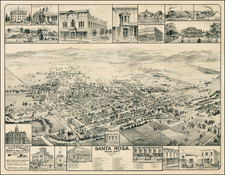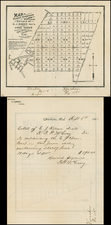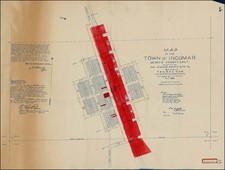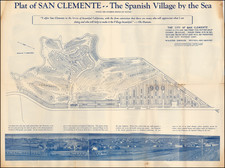Extremely Rare Augustus Koch Bird's Eye of the Capital of California.
Superb three-stone lithographed view of Sacramento, California, produced in 1870 by the master view maker Augustus Koch.
The view is projected with east at the top, the Sacramento River in the foreground, and the American River in the background. Sacramento had been substantially rebuilt after the devastating flood of 1862, and this view is evidence of how far the city had come in 8 years.
The view is characteristic of Koch's excellent compositional skills and his attention to detail; every building is rendered individually, with many numbered (corresponding to a 78-item key), down to the train with "emigrant car" written on passenger cars, and names on some of the riverboats.
The key is one of the more interesting aspects of the view, as it gives a detailed cross-section of what constituted an important public building in Sacramento at the time. For instance, there are six fire engine companies listed: I Confidence Fire Engine House; II Protection Fire Engine House; III Sacramento Engine Company; IV Eureka Engine Company; V Knickerbocker Engine Company; VI Young America Engine Company. In 1872, these would amalgamate into the first paid fire fighting force west of the Mississippi.
This view was completed at the beginning of Koch's career. Koch began producing views in 1868, and for the first two years of his career focused exclusively on Iowa. In 1870, he moved west, making one view in Utah, one in Wyoming, and three in California, including the present title. Koch's output would eventually reach 110 views produced between 1868 and 1898, making this part of the first 10% of his output.
Reps (Views and Viewmarks, page 185), says of Koch:
Koch drew his cities with considerable care, consistently depicting his subjects as if seen from high viewpoints. The horizon lines appear close to the tops of the images, and the body of each print is thus full of urban detail. Koch also used a distinctive format, making his horizontal dimension not much greater than the vertical... He seems to have drawn with substantial accuracy.
Rarity
Reps (Views and Viewmakers 213) lists only three examples: Amon Carter Museum; UC Berkeley; California State Library. The second state, with Snow & Roos as the publisher, is held by only the California State Library.
Augustus Koch (1840-?) was one of the most prolific American engravers of Birds Eye Views working outside of the major publishing centers. Koch initially served in the Union Army during the Civil War as a clerk and draughtsman in the Engineers Office in St. Louis. Although his English was poor, he was later commissioned as an officer and assigned to one of the Black regiments serving in Mississippi where he drew maps for the advancing Union forces. By 1865 he is thought to have contracted malaria and at 25, was discharged from the army.
By 1868, Koch had become an itinerant Bird's Eye View engraver. His earliest dated views are of Cedar Falls, Vinton, and Waterloo, Iowa. At that point his career seemed to take off and in rapid succession, maps by Koch were produced in every section of the country. In 1870 he produced 5 maps in Utah, Wyoming and California. In all, Koch produced over 100 views, including over 20 Texas Views, during a career of 30 years. His last recorded view was produced in Montana in 1898.
Reps notes that while Koch engraved fewer views than some of his contemporaries, "no American viewmaker traveled more widely in search of subjects. . . "












![[Section of Newport Beach]](https://storage.googleapis.com/raremaps/img/small/33577df.jpg)

![[Santa Barbara] Plat Showing Location of Former Bridge on Mission Street over Mission Creek in City of Santa Barbara](https://storage.googleapis.com/raremaps/img/small/92006.jpg)